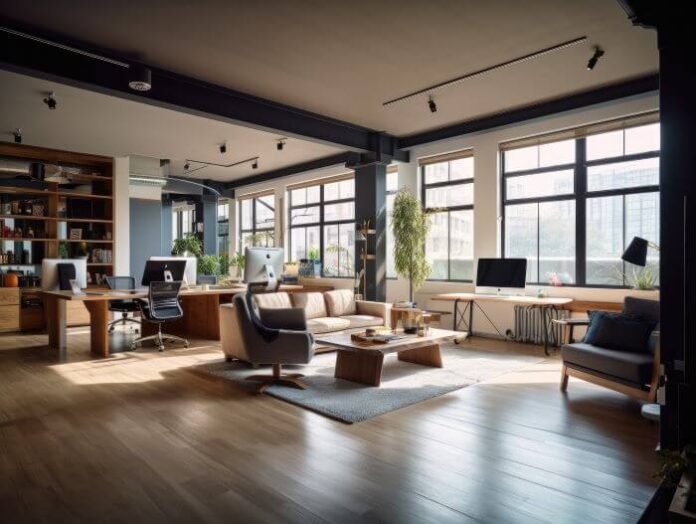Many companies fail to realize that their office space design significantly impacts their employees’ productivity and well-being. A well-designed office layout can enhance workflow and productivity. When employees have a clear and functional workspace, it reduces distractions and allows them to focus on their tasks more effectively.
On the other hand, poorly designed office space can cause distractions, resulting in low productivity and increased employee turnover. Creating an environment that fosters productivity and well-being can improve employee satisfaction and retention, resulting in increased profitability and success.
Here are some interior design tips to help you create a productive office space.
1. Pick The Right Colors
Colors have a significant impact on your mood and behavior. Focus on choosing colors for your office that promote productivity and reduce stress.
Below are some helpful tips to help you choose the right color:
- Blue is a calming color that may help improve focus and concentration.
- Green is a refreshing color for reducing eye strain and boosting creativity.
- Yellow is an energizing color for elevating mood and motivation.
Remember that too much of any color can have the opposite effect. For example, too much blue can make employees feel sad or depressed. Thus, strike a balance and use colors that complement each other.
2. Invest In Ergonomic Furniture
Ergonomic furniture is essential for any office. It can help reduce your employees’ risk of injury, improve their posture, and increase comfort. Investing in ergonomic furniture from reputable companies, like Vision Office Interiors or similar ones, can help employees work more efficiently and effectively.
Consider adjustability, support, and comfort when choosing ergonomic furniture. For example, desks should be at the right height to prevent neck and back pain. Meanwhile, chairs should provide adequate lumbar support. Also, employees should be able to adjust their seats to fit their body size, height, and shape.
3. Optimize Lighting
Like your office furniture, lighting is another critical factor affecting employee productivity. Did you know poor lighting can cause headaches, fatigue, and eye strain? In contrast, good lighting can help improve focus, reduce stress, and boost mood.
Natural light is the best lighting for any office because it’s free and helps regulate your employees’ circadian rhythm, which can improve their sleep quality at night. Hence, it helps to open those office windows during the day or install glass walls to let in natural light.
If natural light isn’t an option, consider using LED lights that mimic natural light. Avoid fluorescent lights, as they can cause eye strain and headaches.
4. Find Ways To Reduce Office Noise
Noise is a common distraction in most offices. Too much noise, whether from the outside or inside, can affect employee productivity and increase stress levels. Therefore, it’s essential to reduce noise levels in the office.
One way to reduce noise is to use sound-absorbing materials such as acoustic panels, carpets, and curtains. These items can help absorb sound waves and reduce echoes. You may also create separate areas for different activities. For example, create a quiet spot for employees who need to focus and a social space for employees who need to collaborate.
5. Personalize The Space
Personalized office space can create a sense of ownership and belonging. It can be as simple as adding pictures or artwork. Encourage your employees to personalize their workspaces. Allow them to bring in photographs, paintings, or other decorative pieces. It can help create a more relaxed and comfortable environment.
6. Bring More Nature Inside
Plants act as natural air purifiers by absorbing carbon dioxide and releasing oxygen. They help filter out toxins and pollutants in indoor environments. Hence, they enhance overall air quality and promote better respiratory health.
In addition, plants can help reduce stress levels and increase creativity. Consider adding plants to the office space. You can designate an area for small potted plants or a vertical garden. Let your employees bring their plants to workspaces or desks to enhance their moods.
7. Invest In Proper Storage
Clutter can be a significant distraction in the office. And one of the primary sources of office clutter is unorganized office files and unused items. Therefore, it’s essential to use proper storage to free up your office space and keep it organized.
Consider using storage solutions such as filing cabinets, shelves, and storage boxes. Keeping workspaces clutter-free can help improve focus and productivity.
8. Provide Adequate Ventilation
Adequate ventilation is essential for a healthy and productive office space. Poor ventilation can cause headaches, fatigue, and reduced cognitive function. Ensure proper air circulation to your office space by installing a ventilation system or opening windows.
Final Thoughts
Creating a productive office space is essential for any business. With these interior design tips, you can create an environment that fosters productivity and well-being. Remember to find the balance and create a space that can be both functional and comfortable. You can also listen to employee feedback regarding your office space’s interior design and adjust as needed.







